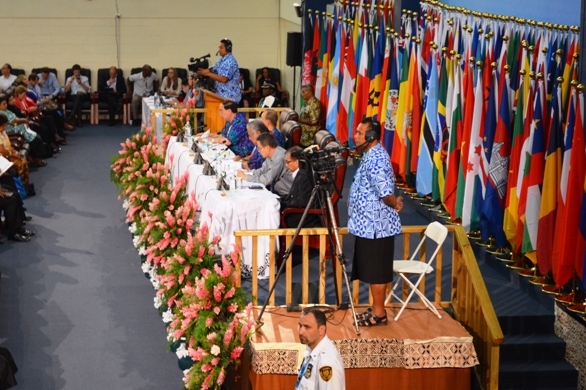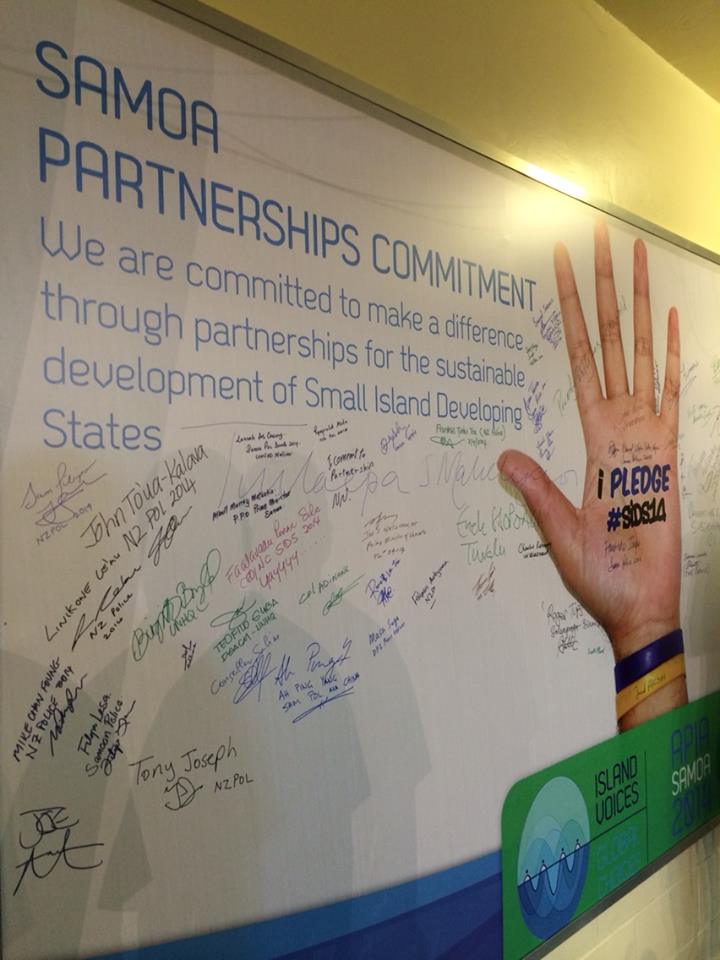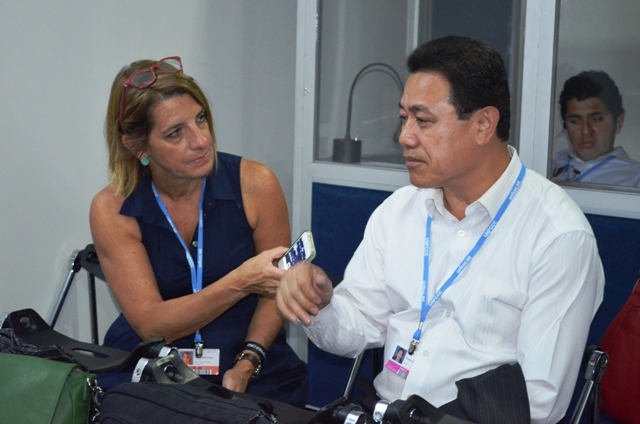
Climate Change Resilience
12 December 2014, Lima Peru - Apia, Samoa shone on the world stage as the host of the Third International Conference of Small Island Developing States, a United Nations Conference that has been held every 10 years. The overarching theme of the Conference was "The sustainable development of Small Island developing States through genuine and durable partnerships".

The conference was considered a success in every way, from smooth logistics with very little hiccups, community ownership and buy-in, the launch of a multitude of SIDS-specific partnerships right down to the heart and substance of the conference itself - the S.A.M.O.A (SIDS Accelerated Modalities of Action) Pathway which represents the sum total of SIDS key challenges and the means of addressing them.
Now just three months after the conference was held in September, we caught up in the margins of the Climate Change Conference in Lima, Peru with Samoa’s Ambassador and Permanent Representative to the United Nations, Aliioaiga Feturi Elisaia to find out what happens now that the conference is over and the SAMOA Pathway had already been endorsed by the UN General Assembly on 14 November.
Q. SPREP What has happened since the Conference in August and September this year? (Note - From 28 - 30 August the pre-conference events were held followed by the conference itself from 1 - 4 September.)
A. AmbassadorAli’ioaiga Feturi ElisaiaAfter the SAMOA Pathway was endorsed by the Conference in Samoa, SIDS worked with their partners to ensure two things were achieved, firstly the adoption of the Outcome document in its totality by the UN General Assembly which happened on 14 November 2014and secondly to have a resolution to implement the main asks in the SAMOA Pathway approved both at the UN Committee level and by the General Assembly subsequently. After weeks of negotiations between SIDS and the UN member states, the implementation resolution was eventually adopted by the UN General Assembly last Friday on 5 Dec 2014.
Now that both the SAMOA Pathway and the implementation resolution have received the seal of approval of the United Nations, the immediate task now is to ensure that SIDS issues are reflected and captured in important multilateral processes currently being negotiated like the Sustainable Development Goals (SDG's) and the post-2015 development agenda, plus pertinent conferences next year like the “3rd World Conference on Disaster Risk Reduction” and the one on “ Financing for Development”.
Q. SPREP And what exactly does the 'real work' entail?
A. AmbassadorAli’ioaiga Feturi Elisaia The SAMOA Pathway calls for a Partnerships Framework. We plan to have discussions with partners, member states and the United Nations Secretariat to work out what this framework should consists of. The implementation resolution calls on the UN Joint Inspection Unit, which is like an audit committee to provide member states with some suggestions on the parameters of such Partnerships framework so that what is finally agreed to is one that will work and be sustainable.
Informally we are also exploring the possibility of the UN Economic and Social Council (ECOSOC) High Level Political Forum designating a day for SIDS which, if the membership agrees, can be used as a platform to monitor and review some of the partnerships launched in Samoa. Such a dedicated day, if promoted well can also be used to launch new partnerships. We envisage the SIDS Day as an avenue for SIDS partners, government, non-government and the private sector to basically continue what was started in Apia, and that was to bring all stakeholders with an interest to assist SIDS in the same room.
For this to work, it is really up to SIDS themselves to advocate the SAMOA Pathway and keep it alive as no one will do it for us - we must do it for ourselves.

Q. SPREP Have there been any challenges in bringing the SAMOA Pathway to this point?
A. AmbassadorAli’ioaiga Feturi Elisaia We came across some technical issues, for instance using the acronym SAMOA in the SAMOA Pathway document. There are six UN languages and apparently one or two of those do not have acronyms or something to that effect. We insisted that SAMOA was both the acronym of the name of the Outcome Document itself and concurrently the name of the host country. At the end we prevailed and the SAMOA Pathway is captured as such in the English version. Our argument was that the use of the acronym was not a last minute decision, as host country a lot of thought had gone in to this.
Now that we have our Outcome document which was agreed to between SIDS and the rest of the UN community, it is important for SIDS to use it as its main point of reference when advocating and articulating SIDS diverse issues, all of which are captured in the document. Repeated reference to the SAMOA Pathway breathes life to the document and ensures its continuing relevance. It should not be allowed to be shelved to gather dust. We must maintain the momentum created by the conference instead of waiting until the five-year review mark comes up before we voice our frustrations and disappointments about missed opportunities and un-met expectations.
Q. SPREP So when it comes to something like this, implementing the SAMOA Pathway, the outcome of the conference, how do you make it work?
A. AmbassadorAli’ioaiga Feturi ElisaiaThe SAMOA Pathway is an international framework like other International frameworks, for instance the Millennium Development Goals (MDG's), The Istanbul Plan of Action for Least Developed Countries and so forth. Because SIDS partners and other UN member states were part of the negotiations and the decisions to endorse the documents, there should be overall support from them when approached for assistance towards their implementation. The SAMOA Pathway should help therefore to garner support from the international community towards SIDS sustainable development needs.
But these frameworks do not necessarily have dedicated funding for implementing all the things being asked in the frameworks. At the end of the day, they are just frameworks. It is really about national governments localising those goals and working with their wide array of partners to achieve some of your sustainable needs. is part and parcel of that.

Q. SPREP How did the partnerships theme contribute to the success of the conference? And how does it fit into the work of implementing the SAMOA Pathway now?
A. AmbassadorAli’ioaiga Feturi Elisaia There were many important ingredients that helped make this conference a success. But I think the underlying theme of partnership with Government working with the whole of Samoa to turn the event into a national undertaking was what carried the day. When I returned to New York there was an overwhelming outpour of positive responses both from Ambassadorial colleagues who went to Samoa and those who didn’t. What I deduced from all these was the perception and sense of strong ownership by the Government and the whole of Samoa of the conference as theirs. That’s what made it uniquely successful.
Q. SPREP So what's going to happen now with the advocacy work of the SAMOA Pathway?
A. AmbassadorAli’ioaiga Feturi Elisaia The SAMOA Pathway is part and parcel now of the United Nations lingo or language, part of the United Nations record and it shows that we have friends out there who want to work in partnership with us. We need to continue to strengthen the level of confidence they have in the SIDS so they will be happy to support and work with us.
Q SPREP And if you had a chance to do it all over again, would you change anything?
A. AmbassadorAli’ioaiga Feturi Elisaia. It’s too early yet to be asking that question. Maybe, in two years’ time, hopefully by then some of the pieces of the jigsaw puzzle would fall neatly in place. I can probably write a book about Samoa’s experience in hosting the conference and some of the firsts along the way in the context of the UN, from setting the dates for the conference, the substitution of Roundtables with Partnerships Dialogues, the push to have all the preparatory meetings completed in New York ahead of the conference, why we resisted calling the Outcome document Apia, and why the SAMOA should be used as the acronym.
Ambassador Ali’ioaiga Feturi Elisaia was a member of the Samoa delegation at the 20th Conference of the Parties to the United Nations Framework Convention on Climate Change in Lima, Peru

The opening plenary of the Third UN Conference on Small Island Developing States in Samoa
The conference was considered a success in every way, from smooth logistics with very little hiccups, community ownership and buy-in, the launch of a multitude of SIDS-specific partnerships right down to the heart and substance of the conference itself - the S.A.M.O.A (SIDS Accelerated Modalities of Action) Pathway which represents the sum total of SIDS key challenges and the means of addressing them.
Now just three months after the conference was held in September, we caught up in the margins of the Climate Change Conference in Lima, Peru with Samoa’s Ambassador and Permanent Representative to the United Nations, Aliioaiga Feturi Elisaia to find out what happens now that the conference is over and the SAMOA Pathway had already been endorsed by the UN General Assembly on 14 November.
Q. SPREP What has happened since the Conference in August and September this year? (Note - From 28 - 30 August the pre-conference events were held followed by the conference itself from 1 - 4 September.)
A. AmbassadorAli’ioaiga Feturi ElisaiaAfter the SAMOA Pathway was endorsed by the Conference in Samoa, SIDS worked with their partners to ensure two things were achieved, firstly the adoption of the Outcome document in its totality by the UN General Assembly which happened on 14 November 2014and secondly to have a resolution to implement the main asks in the SAMOA Pathway approved both at the UN Committee level and by the General Assembly subsequently. After weeks of negotiations between SIDS and the UN member states, the implementation resolution was eventually adopted by the UN General Assembly last Friday on 5 Dec 2014.
Now that both the SAMOA Pathway and the implementation resolution have received the seal of approval of the United Nations, the immediate task now is to ensure that SIDS issues are reflected and captured in important multilateral processes currently being negotiated like the Sustainable Development Goals (SDG's) and the post-2015 development agenda, plus pertinent conferences next year like the “3rd World Conference on Disaster Risk Reduction” and the one on “ Financing for Development”.
Q. SPREP And what exactly does the 'real work' entail?
A. AmbassadorAli’ioaiga Feturi Elisaia The SAMOA Pathway calls for a Partnerships Framework. We plan to have discussions with partners, member states and the United Nations Secretariat to work out what this framework should consists of. The implementation resolution calls on the UN Joint Inspection Unit, which is like an audit committee to provide member states with some suggestions on the parameters of such Partnerships framework so that what is finally agreed to is one that will work and be sustainable.
Informally we are also exploring the possibility of the UN Economic and Social Council (ECOSOC) High Level Political Forum designating a day for SIDS which, if the membership agrees, can be used as a platform to monitor and review some of the partnerships launched in Samoa. Such a dedicated day, if promoted well can also be used to launch new partnerships. We envisage the SIDS Day as an avenue for SIDS partners, government, non-government and the private sector to basically continue what was started in Apia, and that was to bring all stakeholders with an interest to assist SIDS in the same room.
For this to work, it is really up to SIDS themselves to advocate the SAMOA Pathway and keep it alive as no one will do it for us - we must do it for ourselves.

Ambassador Feturi being interviewed by a reporter from the Swiss Info, America's Quarterly at the UN Climate Convention in Lima.
Q. SPREP Have there been any challenges in bringing the SAMOA Pathway to this point?
A. AmbassadorAli’ioaiga Feturi Elisaia We came across some technical issues, for instance using the acronym SAMOA in the SAMOA Pathway document. There are six UN languages and apparently one or two of those do not have acronyms or something to that effect. We insisted that SAMOA was both the acronym of the name of the Outcome Document itself and concurrently the name of the host country. At the end we prevailed and the SAMOA Pathway is captured as such in the English version. Our argument was that the use of the acronym was not a last minute decision, as host country a lot of thought had gone in to this.
Now that we have our Outcome document which was agreed to between SIDS and the rest of the UN community, it is important for SIDS to use it as its main point of reference when advocating and articulating SIDS diverse issues, all of which are captured in the document. Repeated reference to the SAMOA Pathway breathes life to the document and ensures its continuing relevance. It should not be allowed to be shelved to gather dust. We must maintain the momentum created by the conference instead of waiting until the five-year review mark comes up before we voice our frustrations and disappointments about missed opportunities and un-met expectations.
Q. SPREP So when it comes to something like this, implementing the SAMOA Pathway, the outcome of the conference, how do you make it work?
A. AmbassadorAli’ioaiga Feturi ElisaiaThe SAMOA Pathway is an international framework like other International frameworks, for instance the Millennium Development Goals (MDG's), The Istanbul Plan of Action for Least Developed Countries and so forth. Because SIDS partners and other UN member states were part of the negotiations and the decisions to endorse the documents, there should be overall support from them when approached for assistance towards their implementation. The SAMOA Pathway should help therefore to garner support from the international community towards SIDS sustainable development needs.
But these frameworks do not necessarily have dedicated funding for implementing all the things being asked in the frameworks. At the end of the day, they are just frameworks. It is really about national governments localising those goals and working with their wide array of partners to achieve some of your sustainable needs. is part and parcel of that.

The theme of the Conference was - "The sustainable development of Small Island developing States through genuine and durable partnerships" - image courtesy of Amber Carvan
Q. SPREP How did the partnerships theme contribute to the success of the conference? And how does it fit into the work of implementing the SAMOA Pathway now?
A. AmbassadorAli’ioaiga Feturi Elisaia There were many important ingredients that helped make this conference a success. But I think the underlying theme of partnership with Government working with the whole of Samoa to turn the event into a national undertaking was what carried the day. When I returned to New York there was an overwhelming outpour of positive responses both from Ambassadorial colleagues who went to Samoa and those who didn’t. What I deduced from all these was the perception and sense of strong ownership by the Government and the whole of Samoa of the conference as theirs. That’s what made it uniquely successful.
Q. SPREP So what's going to happen now with the advocacy work of the SAMOA Pathway?
A. AmbassadorAli’ioaiga Feturi Elisaia The SAMOA Pathway is part and parcel now of the United Nations lingo or language, part of the United Nations record and it shows that we have friends out there who want to work in partnership with us. We need to continue to strengthen the level of confidence they have in the SIDS so they will be happy to support and work with us.
Q SPREP And if you had a chance to do it all over again, would you change anything?
A. AmbassadorAli’ioaiga Feturi Elisaia. It’s too early yet to be asking that question. Maybe, in two years’ time, hopefully by then some of the pieces of the jigsaw puzzle would fall neatly in place. I can probably write a book about Samoa’s experience in hosting the conference and some of the firsts along the way in the context of the UN, from setting the dates for the conference, the substitution of Roundtables with Partnerships Dialogues, the push to have all the preparatory meetings completed in New York ahead of the conference, why we resisted calling the Outcome document Apia, and why the SAMOA should be used as the acronym.
Ambassador Ali’ioaiga Feturi Elisaia was a member of the Samoa delegation at the 20th Conference of the Parties to the United Nations Framework Convention on Climate Change in Lima, Peru